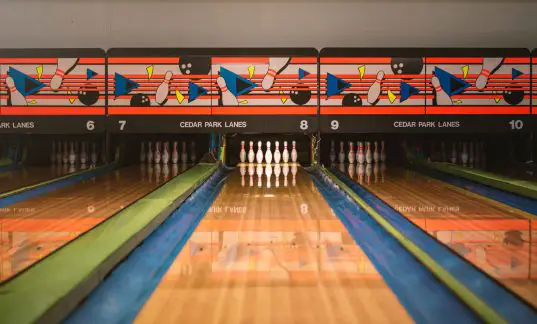You’ve played in tens of bowling alleys during your lifetime and driven by countless more. You know that bowling is one of the most widely played and enjoyed sports in the entire world. But, do you know where it came from and how it became the sport it is now?
We’re here to fill in the bowling history gaps with…
A Brief History Of Bowling Games Around The World
How (And Where) Was Bowling Invented?
While the modern sport of bowling was yet a twinkle in the universe’s eye, the first form of bowling was played in Ancient Egypt some 7,000 years or so ago! Long before bowling balls, bowling clubs, and championship bowling of any kind, Egyptian citizens used rudimentary stone bowling sets for leisure and community. We found this out thanks to the uncovering of Egyptian tombs that included said bowling sets
The bowling game blossomed from the remnants of the Egyptian Empire and found newfound fans around the globe. Different approaches to the bowling ball and the actual structure of the bowling game followed, well before molded finger holes and dedicated bowling lanes.
From Dirt To Lawn Bowling On The Bowling Green
Before the ages of air conditioning and cosmic bowling PA announcers, outdoor bowling, and lawn bowling lanes were the name of the bowling game. Before that, medieval German folks used wooden balls and wooden pins called kegels as a means of absolving sins and proving their religious faith.
Bowling pins were much simpler than they are now. And until the late 13th Century, most bowling took place on dirt or stone floors. From the Roman Empire to the span of Asia, forms of bowling were played under whatever circumstances may come.
The real rise of bowling on the world stage, though, took place on the greens of England. After the first bowling green popped up in Southhampton in 1299, lawn bowling steadily gained in popularity and proliferation. Some games used nine pins. Others used ten pins. Some used as little as three. Regardless, bowling competition was a hit as bowling began to capture the imagination of folks around the globe.
The History Of Bowling Takes A Royal Turn
While it wasn’t the English who invented bowling, it was the English Empire that got the game’s reputation rolling for good. It was so popular among all classes in England that King Henry III banned the game completely since it cut into his soldiers’ time for archery practice.
Regardless of King Henry III’s decree, bowling continued to gain steam — legally or illegally.
By this juncture, bowling had become so popular that the very idea of a bowling lane was becoming more rigid. Rather than bowling on lawns or in any locale that had a flat-enough surface, the game was played indoors — mostly. Roofs were built over lawn bowling playing surfaces to protect playing surfaces from rain and other inclement weather.
The ban was eventually lifted in the 1400s and the masses continued to enjoy the game, whether it was played outdoors or otherwise.
In 1511, King Henry VI banned bowling for lower-class citizens. Once again, the ban didn’t work and the game continued to grow unabated. Heck, King Henry VIII was an avid bowler.
The modern game had yet to find its true definition and the first tenpin lanes were still some time away, but bowling had discovered its audience and fans were about to come in droves.
The Rise Of Tenpin Bowling And Bowling Alleys
Bowling found its footing in many European countries in the 16th and 17th Centuries in several different forms. While women bowlers were often taboo at this time and league bowling was not a thing yet, the nine-pin and tenpin sport were both enjoyed by people of all classes across the continent.
And when settlers from European countries like Germany and England reached the Americas, they brought bowling with them. Nine-pin bowling was the game of choice for many, but ten-pin bowling soon usurped it as the colonies became the United States of America.
Bowling halls were commonplace from New York City to rural towns by 1820. At this time, gambling began to find its way into the sport and several states instituted temporary bowling bans in response.
But just like in Great Britain, bowling was always two steps ahead of the law. The bans were soon lifted and the game continued to evolve. The bowling hall would soon be replaced by the modern bowling center, and the true boom of American bowling (and bowling altogether) would take place.
The Bowling Boom And The True Emergence Of The Tenpin Game
When the age of television began in the late 1920s, there was a need for quality programming that could capture the imagination of the viewing public.
Enter bowling.
The big reason why bowling was such a prime pick for network programming slots had a lot to do with the major boom period it had already been experiencing for decades.
From being namechecked in Rip Van Winkle in 1819 to absolute global domination less than a century later, bowling really took off when nine bowling clubs merged to form the United Bowling Clubs in 1895. This would eventually become the American Bowling Congress — one of the most influential governing bodies in the history of tenpin bowling.
In 1916, the International Bowling Association was established to coordinate international amateur competition across the globe.
And seeing that women were mostly banned (or strongly discouraged) from bowling with men in clubs at that time, women bowlers took the bowling bull by the horns — eventually establishing the Women’s International Bowling Congress in 1917.
It didn’t stop there. Over time, the game saw the establishment of the Bowling Proprietors Association (1932), the National Bowling Association (1939), the British Tenpin Bowling Association (1961), the Young American Bowling Alliance (1982), and the United States Bowling Congress (2005) among many others.
In the middle of all this, pro bowlers took center stage on millions of television screens. The births of the Professional Bowlers Association (1958) and the Professional Women’s Bowling Association (1960) brought high-level bowling competition to the masses. This was still the age of the rubber ball, though, and the game continued to grow even more as technology caught up and better bowling balls were made available to the masses.
The money was great for pro bowlers for decades after this. Bowling league play was a staple of modern American life. As America was reshaped by internal tensions and the existential threats of World War II and Vietnam, bowling provided a needed respite. And it was a respite that made money for many people!
Bowling Faces An Uncertain, But Optimistic Future
Things are different in the bowling world right now. Due to the COVID-19 pandemic, headcounts at local bowling alleys have dropped considerably. And while PBA and Ladies Pro Bowlers Tour (formerly the PWBA) purses are large on the high end, the average pro bowler makes a pittance compared to pro athletes in other sports.
It’s an interesting time for bowling around the world. There are still millions upon millions of people who enjoy the game — whether that means watching it on TV, playing it, or both. And every time we’ve ever tried to count bowling out, it finds a way to gather momentum and make a whole new generation of fans and bowlers.
The technology of bowling balls has never been more cutting-edge. The ways that we can enjoy the game, from video games to arcade floors, have increased. Bowling is a part of our culture and has been for thousands of years. And it will be, in some form or another, for thousands more to come.


